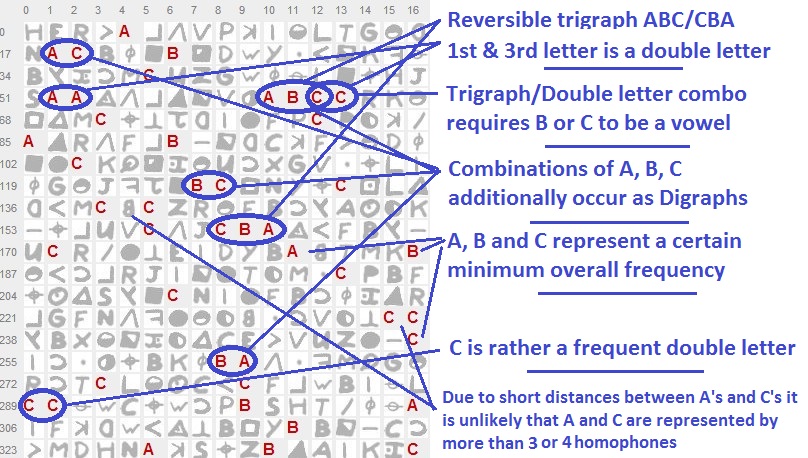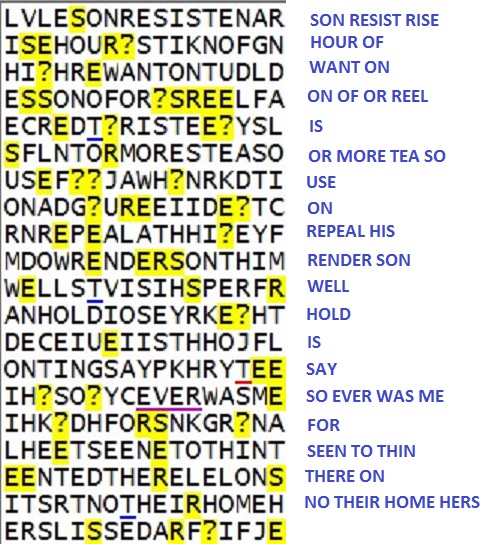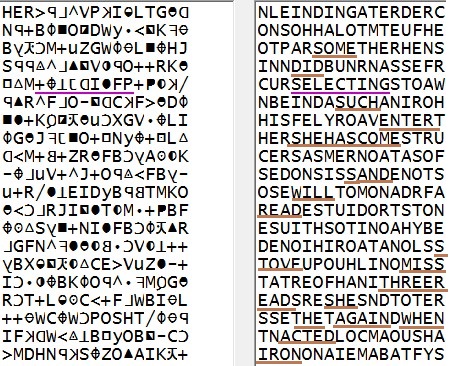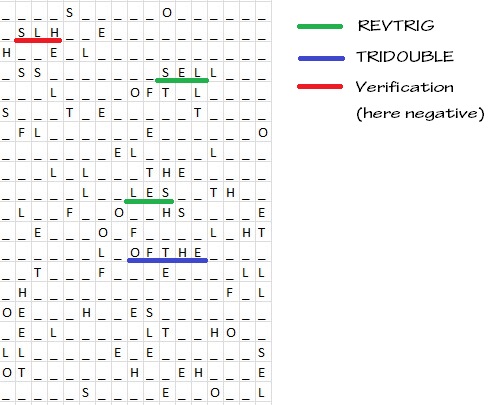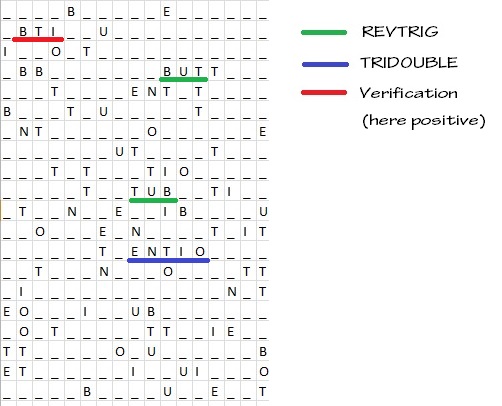UPDATE:
The 340 even contains a reversible trigraph:
pO++ contains pO+ which actually occurs reversed as +Op in line 10 of the chiper again. However not all trigraphs are valid (or common) to be reversible.
NCE for example leads to ECN and not many English words start with either ECN or CN. Also, not many words end with EC.
Therefore we are looking for a reversible trigraph for this three symbol combination. Such as:
ARE – ERA (like ERASED)
BUT – TUB (like TUBE)
DER – RED (…)
HER – REH
ION – NOI
IDE – EDI
ISE – ESI
MAN – NAM
NOT – TON
ONE – ENO
ONS – SNO
PER – REP
PRO – ORP
RES – SER
ROM – MOR
STA – ATS
STI – ITS
TED – DET
TEN – NET
TER – RET
TOR – ROT
VER – REV
HIS – SIH
NOM – MON
EVO – OVE
WAS – SAW
LET – TEL
LAT – TAL
Furthermore, the first and last letter of such a reversible trigraph may be a double letter as the ++ occurs three, the pp combination one time in the cipher. This at least gives us some additional information, e.g. that if the + represents the letter ‘L’, the symbol p represents most likely the letter ‘T’ (as LAT-TAL is a reversible trigraph for words such as LATE and TALL). REV-VER therefore is not a very good candidate, as no words with REVV… may exist and the letter V would not very likely represent the double symbol pp, which in that case would be VV.
Update:
And not to forget, the trigraph should contain a frequent digraph as well because Op occurs at least twice (with other homophones not yet considered). This digraph would occur in the last two symbols of the trigraph (because of +Op in line 10 of the cipher). Therefore according to Scott Bryce interesting tri-/digraph candidates would be (bold trigraphs to be placed in line 10):
RED – DER
MAN – NAM
MON – NOM
ARE – ERA
LAT – TAL
TEN – NET
RES – SER
STI – ITS
HIS – SIH
WAS – SAW
IDE – EDI
Although this is still showing a variety of possibilities for this particular trigraph/digraph, it may well be combined with other areas of the cipher to find a partial solution. Also it shows that O would rather be a vowel than a consonant. In seven of those 12 cases considered, O would represent either the letter ‘A’ or ‘E’.
According to the assumptions mentioned so far, cleartext possibilities for the following symbols may be:
+
A D H I L M R S T W
O
A D E I O R T
p
D E I N R S T
with + and p representing a double letter.
QT
*ZODIACHRONOLOGY*
UPDATE:
The 340 even contains a reversible trigraph:
pO++ contains pO+ which actually occurs reversed as +Op in line 10 of the chiper again. However not all trigraphs are valid (or common) to be reversible.
Cool observation, QT. I’m sure someone has tried the approach of, for instance, reading the even lines right to left in a "labyrinth" approach, which could account for the reversible trigraph.
—–>
—–<
>—–
—–<
It’s an example of guessing the encoding method based on these types of observed anomalies in the symbols. Rather than interrupted your partial solution thread, I think there should be "340 approaches" thread. I think there was one either on the old board or perhaps ZKfacts but I couldn’t find it here.
..in line 4, the 340 cipher contains the
pO++
symbol combination and is there a reversed
+Op
in line 10 as well. The first symbol, p, also occurs as a double letter in line 4. We therefore are searching a reversible trigraph in which both, the first as well as the third letter, represent a double letter. In addition to that, the first and the third letter of (one of) the trigraph(s) occurs as a digraph in line two. So does the first/last two letters occur as a digraph in line 16.
According to this, I have set up some criteria to find the ‘correct’ trigraph:
POS 123 – MUST BE A REVERSIBLE TRIGRAPH
POS 23 – MINIMUM ONE VOWEL/CONSONANT
POS 1 – ONE DOUBLE LETTER PER 340
POS 1 – OVERALL FREQUENCY MIN ~3.24%
POS 3 – TWO/THREE DOUBLE LETTER PER 340
POS 3 – OVERALL FREQUENCY MIN ~6.76%
POS 3 – MAXIMUM OF ~3 HOMOPHONES
POS 1 – MAXIMUM OF ~3 HOMOPHONES
POS 21 – DIGRAPH FREQUENCY OF 0.58%
POS 13 – DIGRAPH FREQUENCY OF 0.29%
and did I check the following list of (reversible) trigraphs:
ARE
BUT
DER
EVO
HER
HIS
MAN
NOM
NOT
ONE
ONS
PER
PRO
RES
ROM
SAW
SAL
SPL
STA
STI
TED
TER
TOR
VER
considering that those reversible trigraphs must be checked against those criteria into both directions (ABC and CBA).
Checking the trigraphs against the previously mentioned nine criteria, all of them fail. This does not necessarily mean that they are wrong, however only 10 out of 48 trigraphs match at least eight of those nine criteria. Those trigraphs are:
DER
HER
HIS
RES
REH
MOR
DET
RET
ROT
SAL
Althought there might exist more reversible trigraphs with such a match (at least 8 of 9 criteria), those are currently my favorites for the pO+ cipher part. And this group might still be differentiated:
We may assume that the third letter is not allowed to be represented by more than 3 homophones (as a knock-out criteria). This because otherwise chances would be very low that three double letters are represented all by the same double symbol (with actually only two double letters statistically expected, even for the letters ‘LL’ or ‘EE’). Therefore, those trigraphs containing letters on the third position with an (statistically) expected 4 or more homophones may be excluded, leading to the following list:
DER
HER
SAL
SEL
REH
MOR
REH – fulfilling 8 out of the 9 criteria – may not yet be excluded just because it appears to be unlikely that three ‘HH’ occur in the cleartext. WITHHER WITHHELD and other word combinations could lead to the occurance of three ‘HH’, whilst we cannot yet see the double ‘LL’s due to e.g. four homophones representing the letter ‘L’. An overall frequency of the letter H, approximately 6%, would also still comply with the 24 + symbols in the cipher.
Conclusion:
Not all but some frequent reversible trigraphs have been considered here and were later matched against various criteria which had been derived by the symbol structure of the cipher. Those nine criteria are fulfilled only by few, if at all, reversible trigraphs. Out of those, some reversible trigraphs may be excluded due to knock-out situations, e.g. the expectation of three double symbol combinations of a letter represented by 4 or more homophones. Three out of six selected trigraphs end with the letter ‘R’, two out of six end with the letter ‘L’. Unless modification of either the list of reversible trigraphs or the criteria catalogue, it therefore is very likely that the symbol + represents either the letter ‘R’ or ‘L’. All assumptions based on a homophone cipher structure with an at least stable distribution of homophones according to a letter frequency table and usage of homophones in at least partially repeating homophone sequences (comparable to 408). Overmore, the center letter of the trigraph appears to be a vowel, most likely an ‘E’.
QT
*ZODIACHRONOLOGY*
Added the reversible trigraphs of the following list:
http://www.mcld.co.uk/decipher/longenglish.htm
(thx for the brits for this one)
TTH
SIN
STH
LEA
ILL
ERS
ETO
in fact there is another reversible trigraph (revtrigraph) matching 8 of the nine criteria (criteria derived from the symbol structure of the 340).
It’s the ERS revtrigraph, however in reversed version, therefore SRE. This one is the first implying that the + symbol may represent the letter ‘E’.
Although no final solution yet, I think I meanwhile get some good results sometimes, comparable to the following..
QT
*ZODIACHRONOLOGY*
Some more progress with the 340..
This time the task was to identify the possibility of the word ‘you’ (or ‘your’). This word is interesting for various reasons:
– Y doesn’t occur very often (statistic says approximately 6 times
– U doesn’t occur very often either (approximately 9 times
– According to Z’s letter frequency table, both letters are represented by one homophone (symbol) only
Regarding the third criteria it should be understood that, in the 408, Z did not choose the amount of homophones according to the alphabetical letters he had used in the cipher, but rather had chosen this amount according to a separate frequency table. For example he had used only one symbol for the letter ‘P’ which occured 7 times but had used two symbols for the letter ‘D’, although having the same frequency. Please not that, besides few letters, the number of homophones in this cipher comply with their general statistical frequency.
So we may (or may not) assume that Z had taken the same letter frequency table to distribute homophones for the alphabetical letters. Due to the frequency of the letters ‘U’ and ‘Y’, their amount of homophones was only one (symbol).
So we further assume that Y and U do not occurr exactly 6 and 9 times, however we may also assume that abberation will not be greater than 40% (e.g. an occurrance of 2 times for the letter ‘Y’).
Then again, the ‘OU’ digraph of the word ‘You’ is rather a frequent one. We therefore may assume that ‘OU’ occurs at least two or three times and therefore might show up as a (symbol) digraph in the cipher. One more thought: If the letter before this digraph is e.g. ‘+’, we also may rule this specific digraph out as the letter Y would rather not occur three times as a double letter. Also the reversed ‘P’ symbol would rather not represent the letter Y becaus of its double letter occurrence. And, finally the reversed ‘P’ together with the triangle symbol with a dot inside would not work as this would represent three (phonetic) vowels in a row.
Overall we can start to select:
1. We got 21 digraphs in the 340
2. Due to the double letter, which rather is not (you underestimate could actually work..), representing the letter ‘U’, we do rule out the reversed P symbol if it is located on the second position of the digraph
3. We do check the overall frequency of the second digraph symbol, if it complies with the frequency of the letter ‘U’
4. Due to multiple homophones to be expected, the letter ‘O’ may be present only once or up to 12 times, therefore we cannot use the first digraph symbol in compliance with any letter frequency (no selection)
5. However we can check the symbol directly before the (remaining) digraphs, if its frequency complies with the frequency of the letter ‘Y’.
This is the result, therefore possible locations for the word YOU:
QT
*ZODIACHRONOLOGY*
Another approach.
Let’s assume for a second that Z had used the word HAVE in his cipher. This word containing the digraph AV could also be found in words such as LEAVE or AVERAGE or AVERY etc.
Now luckily, the letter V is not very common at all. In fact it has a frequency of approximately 1.0%, therefore should occur only about three times in the 340 cipher. This may or may not be something between two and four Vs in the cipher. With an overall frequency of only 1%, someone may expect (according to the cipher structure of the 408), that the letter V is represented by one single homophone only.
The digraph AV contains the letter A, which is way more frequent and therefore is likely be represented by more than one homophones. However, we could have a possible hint if we go for some luck now:
IF the letter V has a frequency of 2-4 times in the 340, the A may (or may not) be present at least 2-3 times previous to the symbol representing the letter V. In detail:
– V has a frequency of approx. 1.0% and is therefore represented by only one homophone
– V occurs approximately 2-4 times in the 340 cipher
– Homophones which are present less than 2 or more than 4 times may be ruled out
– Symbols previous to the (questionable) homophone representing V are likely to represent the letter A
– A has more than one homophones, likely represented by 4-6 different symbols
Now some conclusion:
IF A repeats in sort of a homophone sequence (repeating its various symbols in an unknown order), it MAY accidentially lead to a digraph combination. Therefore first a homophone with frequency 2-4 must be identified as being the second letter of the digraph (V). This leads to a group of 28 homophones which may possibly represent the letter V. Out of those 28, the letter A may possibly occur at least twice previous to this particular homophone.
Because as A is repeating its homophones (and is present not only in connection with the AV digraph), the homophones may repeat in sort of a homophone sequence. It therefore could eventually happen that one of the homophones representing A shows up again in the position previous to the homophone representing ‘V’.
An example:
Four words present with the letter V:
HAVE
LEAVE
REVEREND
SHAVE
Three of the V’s have the letter A as a digraph (AV). According to its frequency, V is likely be represented by only one homophone (let’s say it is now represented by a number, e.g. 9):
HA9E
LEA9E
RE9EREND
SHA9E
The homophones for the letter A will now differ. The homophones of A are all over the cipher, repeating in various combinatinos, e.g. by 5 different homophones (here we’ll use numbers 1-5 for homophones representing the letter A):
12345 12345 345 1245 etc.
The A shows up everywhere, but let’s assume that – accidentially – the bold printed numbers represent those homophones for the letter A which are located previous to our unique V homophone. In that case we get the result:
H29E
LE59E
RE9EREND
SH29E
leading to a digraph (29) of which the latter symbol has an overall frequency of 2-4.
Of course it is still possible that, due to the amount of homophones representing the letter A, the letter V may not show up as a digraph. But IF the letter A accidentially occurs twice in an identical form previous to the V homophone, we get a digraph with V’s frequency approximately 1%.
Now out of those selected 28 homophones (frequency 2-4 times in the 340), which one is such a possible AV digraph?
As far as I could see it’s only one homophone fulfilling those criteria: The Z symbol. It is the only homophone with a frequency of 2-4 per 340 which at the same time shows up as a digraph together with another symbol. The combination in fact is UZ, so the symbol U may (or may not) be one of the homophones representing the letter A.
Thoughts.
We may continue with the
+b+Z combination in line 9 of the 340 cipher. In that case, e.g., it is unlikely that + is represented by the letter L. We do assume that + may (or may not) be a frequent letter such as T, E, L etc. with double letter frequency of at least one per 340. If we choose the letter E for the + symbol, however, we end up with many words such as ‘irrelevant’, ‘eleven’ etc.
So we may replace:
+b+Z to ELEV
and do get a small confirmation in line three of the cipher:
+UZ is now a EAV trigraph, which may or may not be common in a word such as LEAVE.
So far. Please not that a similar scenario may also be possible with the digraph EV instead of AV, this leads e.g. to approaches like the following one:
QT
*ZODIACHRONOLOGY*
Ok it paid off…finally I was able to solve the 340, although its meaning is very weird. Nevertheless – it does show clearly the insane behaviour of Z, although I still have no idea about which victim he actually talks about. Here you go with the solution, which appears to be valid although he actually again had included at least one writing error (scroll the pic down to see the full text…it seams as if he got interrupted while doing the cipher):
Any ideas about it?
QT
*ZODIACHRONOLOGY*
Fascinating QT. I wonder how we could find out who Mel Belli’s neighbor was at the time of the killings? It would be worth checking into. I haven’t been on here in a while and am amazed at how far the 340 has come. Awesome job to you and all who have been working so hard at solving it. ![]()
It is a riddle, wrapped in a mystery, inside an enigma; but perhaps there is a key.
~Sir Winston Churchill in reference to Russia
These are my least favorite threads to read, because I spend hours looking at the ciphers and peoples take on them, and then I get frustrated because I try all kinds of different ways to figure them out and I don’t even come close… Zodiac, if you are still alive, stop being a beotch and give us the answer!!!!! Of course, this could all be nothing more than a way to mess with the cops and/or FBI’s heads and there is nothing to solve.
A few minutes ago on a toilet not very far, far away….
Please be aware that the offered solution was an April fool joke..sorry for anbody disappointed by it but I could not resist ![]()
QT
*ZODIACHRONOLOGY*
Please be aware that the offered solution was an April fool joke..sorry for anbody disappointed by it but I could not resist
QT
lol
I fall for that, but will that has some truth to it all
cheers from Brazil!!! ![]()
https://zodiacode1933.blogspot.com/
QT…you rascal!! I wondered if it might be an April Fool’s joke but you seemed pretty convincing in your delivery.
I fell for it hook, line, and sinker. ![]()
I also fell for it once when a coworker told me they removed the word gullible from the dictionary, lol!!
Good one QT ![]()
It is a riddle, wrapped in a mystery, inside an enigma; but perhaps there is a key.
~Sir Winston Churchill in reference to Russia
QT…you rascal!! I wondered if it might be an April Fool’s joke but you seemed pretty convincing in your delivery.
I fell for it hook, line, and sinker.
I also fell for it once when a coworker told me they removed the word gullible from the dictionary, lol!!
Good one QT
Rascal lol.
A few minutes ago on a toilet not very far, far away….
The 340 basically contains at least two (repeating) trigrams. In line 13, those two trigrams are even connected to each other (‘IoF’ & ‘FBc’, therefore ‘IoFBc’). For better understanding, I’m going to call this one a TRIDOUBLE. It only does occurr once in the cipher.
Furthermore, in line 4, there is a ‘pO+’ trigram which occurs – reversed – in line 10 again (‘+Op’). I’m going to call this one a REVTRIG, for the only reversed trigram of the cipher.
All symbols in this TRIDOUBLE and REVTRIG cipher structure together actually do represent 94 letters or 28% of the cipher. Therefore, by identifying those two structures, more than a quarter of the cipher would be immediately solved. Statistically this is still a challenging task (26^8, therefore approximately 208 billion possibilities).
However, a trigram rather wouldn’t repeat twice in a cipher if it was’nt a common one, such as the trigrams AND, THE, EST, ION etc.
Taking this for granted, especially for the first part of the 5-digit TRIDOUBLE , we simultaneously get access to the first letter of the second (repeating) trigram. In our example, this would be D, E, T, N, etc., leading to another selection for the second trigram (e.g. DEL, EST, THE, NOT, etc.).
In fact, trigrams have certain frequencies in the English language. THE, for example, occurs way more often than e.g. XYT. In addition to that, THE & XYT wouldn’t go together in a TRIDOUBLE structure, as XYT starts with a different letter than THE actually ends with.
THE & END, however, would actually work quite well as the TRIDOUBLE ‘THEND’.
Common TRIDOUBLEs for example are:
NDENT
THENT
ENTHE
THAND
ENTIS
IONCE
OFTHE
ENTIO
THING
ESTHE
ESTHA
NTION
So far I could not find any statistics about the frequency of reversable trigrams (REVTRIGs), the only I could find was that one:
We consider the population of trigrams in printed English of the form consonant1-vowel-consonant2. It is shown that, if a trigram C1VC2 is an English word, then its symmetric permutation, C2VC1, is likely to be an English word more often than expected on the basis of the ratio of all words to all trigrams. It was conjectured that the set of trigram words tends to be closed under the formation of mirror images; i.e., the permutation of the consonants of one trigram word yields another trigram word rather than nonsense. But it is shown that the number of symmetric combinations (C1VC2: C2VC1), both of which are words, can be predicted from 1) the relative frequencies of letters in all trigram words and 2) the particular frequency distributions of consonants in C1 and C2.
http://onlinelibrary.wiley.com/doi/10.1 … 0/abstract
So we learn that many REVTRIGs may be part of the English language in both directions.
Combining a REVTRIG together with a TRIDOUBLE, however, sadly leads to only one (non-repating) trigram in line 2 of the cipher: ‘p+B’. This may be used as a verification if the combination of a specific TRIGRAM together with a REVTRIG is a valid one or not. In the following example, we can find out that the combination of the REVTRIG ‘SEL’ together with the TRIDOUBLE ‘OFTEN’ would actually not work:
Other combinations, however, would indeed lead to a possible partial solution, e.g. the combination of ‘BUT’ as a REVTRIG together with ‘ENTIO’ as a TRIDOUBLE. Knowing that the REVTRIG in line 4 of the cipher is part of a double letter (‘++’), this combination could lead to two cleartext words in the 340: ‘BUTT’ or ‘BUTTER’ and e.g. ‘MENTION’. The word ‘INTENTION’ would not work, as the text phrase in line 13 is structured as following: T_ENTIO (therefore ‘INTENTION’ is no possible solution).
In addition to that, the verification is also positive as ‘BTI’ (in line 2) could represent the phrase ‘DOUBT I’ or ‘DOUBT IF’ etc.:
An approach to crack the 340 therefore is (all under the assumption of the cipher being a homophone cipher comparable to the 408):
1. Setting up two trigrams combinable as a TRIDOUBLE
2. Setting up a reversable trigram as a REVTRIG
3. Checking for validity in line 2 (‘p+B’)
4. Guessing phrases, e.g. like the word ‘MENTION’ to gain access to further symbols or running such REVTRIG & TRIDOUBLE structures through a cipher solving program, e.g. ZDK.
Statistically the possibilities for the cleartext is now tremendously reduced, especially if we assume the REVTRIG to contain at least one vowel (because it’s followed by a double letter ‘++’, if not two words are exactly separated inbetween these two symbols, which however may be the case):
Frequent trigrams repeating AND combining them to a TRIDOUBLE – approximately a maximum of 20-100 possibilities (I found 10-20..) MULTIPLICATED with a three-letter REVTRIG is an estimated combinations to be checked:
20 TRIDOUBLES x 26 REVTRIG-LETTERS x 26 REVTRIG-LETTERS x 5 REVTRIG-VOWELS = a maximum of 67,600 possibilities to crack 28% of the cipher.
Assuming only approximately 100 REVTRIGs to be ‘common’, we even get only 20×100 therefore 2,000 possibilities (which is incredibly low..mostly I end up with 200,000 possibilities or more). This, however, can be furtherly reduced considering the pO++ structure as being one word only, e.g. ‘CALL’ leading to ‘CAL’ as the REVTRIG – then combining it with the approximately 20-100 TRIDOUBLEs.
So or so, I believe this might be a way better approach than simply guessing one symbol after another..
QT
*ZODIACHRONOLOGY*
